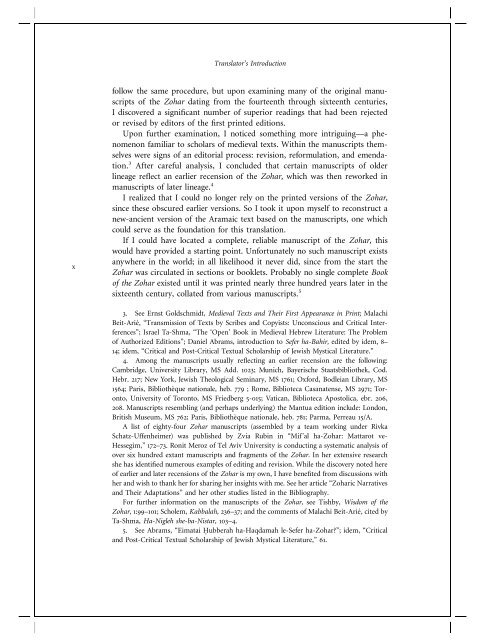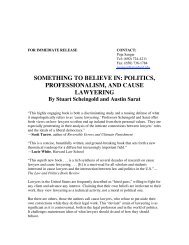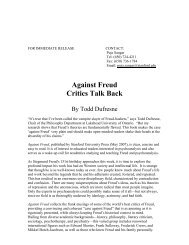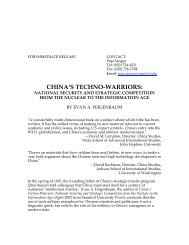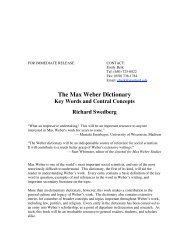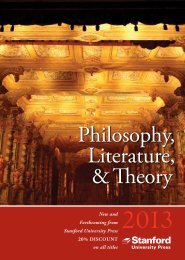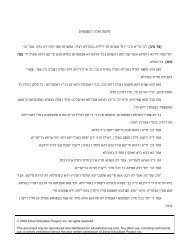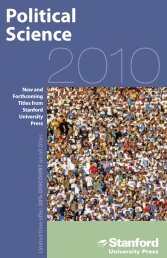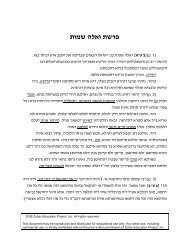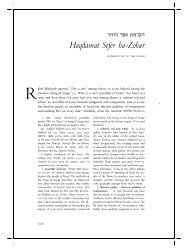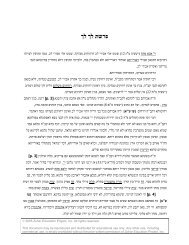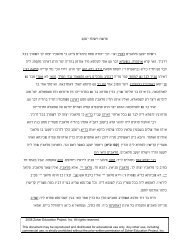Front Matter (PDF) - Stanford University Press
Front Matter (PDF) - Stanford University Press
Front Matter (PDF) - Stanford University Press
Create successful ePaper yourself
Turn your PDF publications into a flip-book with our unique Google optimized e-Paper software.
the same procedure, but upon examiningmany of the original manuscripts<br />
follow<br />
of the Zohar datingfrom the fourteenth through sixteenth centuries,<br />
discovered a signi®cant number of superior readings that had been rejected<br />
I<br />
revised by editors of the ®rst printed editions.<br />
or<br />
further examination, I noticed something more intriguingÐa phenomenon<br />
Upon<br />
familiar to scholars of medieval texts. Within the manuscripts them-<br />
were signs of an editorial process: revision, reformulation, and emendationselves<br />
3 After careful analysis, I concluded that certain manuscripts of older<br />
re¯ect an earlier recension of the Zohar, which was then reworked in<br />
lineage<br />
of later lineage. 4<br />
manuscripts<br />
realized that I could no longer rely on the printed versions of the Zohar,<br />
I<br />
these obscured earlier versions. So I took it upon myself to reconstruct a<br />
since<br />
version of the Aramaic text based on the manuscripts, one which<br />
new-ancient<br />
serve as the foundation for this translation.<br />
could<br />
I could have located a complete, reliable manuscript of the Zohar, this<br />
If<br />
have provided a startingpoint. Unfortunately no such manuscript exists<br />
would<br />
in the world; in all likelihood it never did, since from the start the<br />
anywhere<br />
was circulated in sections or booklets. Probably no single complete Book<br />
Zohar<br />
the Zohar existed until it was printed nearly three hundred years later in the<br />
of<br />
century, collated from various manuscripts. 5<br />
sixteenth<br />
See Ernst Goldschmidt, Medieval Texts and Their First Appearance in Print; Malachi<br />
3.<br />
``Transmission of Texts by Scribes and Copyists: Unconscious and Critical Inter-<br />
Beit-ArieÂ,<br />
Israel Ta-Shma, ``The `Open' Book in Medieval Hebrew Literature: The Problem<br />
ferences'';<br />
Authorized Editions''; Daniel Abrams, introduction to Sefer ha-Bahir, edited by idem, 8±<br />
of<br />
idem, ``Critical and Post-Critical Textual Scholarship of Jewish Mystical Literature.''<br />
14;<br />
Amongthe manuscripts usually re¯ectingan earlier recension are the following:<br />
4.<br />
<strong>University</strong> Library, MS Add. 1023; Munich, Bayerische Staatsbibliothek, Cod.<br />
Cambridge,<br />
217; New York, Jewish Theological Seminary, MS 1761; Oxford, Bodleian Library, MS<br />
Hebr.<br />
Paris, BibliotheÁque nationale, heb. 779 ; Rome, Biblioteca Casanatense, MS 2971; Toronto,<br />
1564;<br />
<strong>University</strong> of Toronto, MS Friedberg5-015; Vatican, Biblioteca Apostolica, ebr. 206,<br />
Manuscripts resembling(and perhaps underlying) the Mantua edition include: London,<br />
208.<br />
Museum, MS 762; Paris, BibliotheÁque nationale, heb. 781; Parma, Perreau 15/A.<br />
British<br />
list of eighty-four Zohar manuscripts (assembled by a team workingunder Rivka<br />
A<br />
was published by Zvia Rubin in ``Mif'al ha-Zohar: Mattarot ve-<br />
Schatz-Uffenheimer)<br />
172±73. Ronit Meroz of Tel Aviv <strong>University</strong> is conducting a systematic analysis of<br />
Hessegim,''<br />
six hundred extant manuscripts and fragments of the Zohar. In her extensive research<br />
over<br />
has identi®ed numerous examples of editingand revision. While the discovery noted here<br />
she<br />
earlier and later recensions of the Zohar is my own, I have bene®ted from discussions with<br />
of<br />
and wish to thank her for sharingher insights with me. See her article ``Zoharic Narratives<br />
her<br />
Their Adaptations'' and her other studies listed in the Bibliography.<br />
and<br />
further information on the manuscripts of the Zohar, see Tishby, Wisdom of the<br />
For<br />
1:99±101; Scholem, Kabbalah, 236±37; and the comments of Malachi Beit-ArieÂ, cited by<br />
Zohar,<br />
Ha-Nigleh she-ba-Nistar, 103±4.<br />
Ta-Shma,<br />
See Abrams, ``Eimatai Ḥubberah ha-Haqdamah le-Sefer ha-Zohar?''; idem, ``Critical<br />
5.<br />
Translator's Introduction<br />
x<br />
and Post-Critical Textual Scholarship of Jewish Mystical Literature,'' 61.


